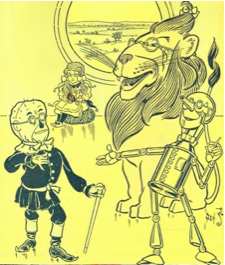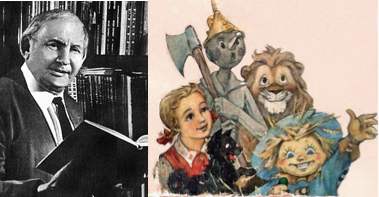The Wonderful Russian Wizard of Oz
by Burkard Polster and Marty Ross
The Age, 19 March 2012

When L. Frank Baum’s The Wonderful Wizard of Oz appeared in 1900 it proved an instant success. One of Baum’s major inspirations was Lewis Carroll’s Alice in Wonderland, resulting in many similarities between the stories: both feature a young girl as the (sort of) heroine, a journey into a magical realm, the inclusion of many pictures, and so on.
Your maths masters are big fans of both books. However, for us Alice definitely has the edge, not least because the author Lewis Carroll (Charles Dodgson) was also a mathematician. Carroll included many mathematical and logical gems in Alice in Wonderland, some only just poking above the surface. It is all carefully and entertainingly discussed in Martin Gardner’s superb Annotated Alice.
By comparison, we are not aware of anything particularly mathematical about the Wizard or its author. However, Baum did create the world of Oz, which is almost as close to our hearts as mathematics. (True, Baum once revealed that the name of the magical land was inspired by a drawer in his file cabinet, labeled “O-Z”, but we just pretend we never heard that.)
Moreover, there are two mathematical stories that retrospectively attached themselves to Baum’s classic story.
Many of our readers will be familiar with the first story, which arises from the mega-famous 1939 movie musical adaptation of Baum’s book. In this movie, as in the book, the Scarecrow wishes for a brain, and the Wizard grants his wish, more or less, by offering him a diploma: a Doctor of Thinkology. Then, in the movie (and definitely not in the book), the Scarecrow tests his newly gained intelligence by having a go at some mathematics:
The sum of the square roots of any two sides of an isosceles triangle is equal to the square root of the remaining side—Oh, joy! Rapture! I’ve got a brain!
The Scarecrow and his companions are definitely impressed, though nobody familiar with Pythagoras’s theorem would be. (And neither is Homer’s bathroom companion in The Simpsons reprise of this famous scene).
For the record, let’s document the Scarecrow’s errors: first it should be “squares” instead of “square roots”; second, “any two sides” should be “the two shorter sides”; and finally, “isosceles triangle” should be “right-angled triangle.” And, as one can see from the picture below, no triangle will satisfy the Scarecrow’s peculiar theorem.

Notably, Baum’s original story contains none of the Scarecrow’s mathematical nonsense. Indeed Baum, through the words of the Wizard, declares his clear scepticism of the notion of granting brains (or wisdom), and only reluctantly accedes to the Scarecrow’s request. The Scarecrow then wisely refrains from testing out his new brains (made of bran).
We only recently became aware of the second mathematical curiosity associated to Baum’s story. One of your maths masters grew up in Germany and as a child had never heard of The Wonderful Wizard of Oz. When he finally did so as an adult, he was surprised to find that the story was almost identical to a different story from his youth: the 1939 book The Wizard of the Emerald City by the Russian author Alexander Melentyevich Volkov.

It turns out that Volkov stumbled across Baum’s book while studying English. He decided to translate the book into Russian, but in the process he began to make changes and to add his own creations. The result was a story similar to Baum’s but also very different. (There actually exists an English translation of Volkov’s version, a translation of a translation.)
Now, here’s the mathematical connection. Volkov, the author of the Russian Wizard, was first a teacher and then a professor of mathematics. Following the success of his Wizard book, and his subsequent sequels, Volkov also published a number of well received popularisations of mathematics and science for kids.
As a mathematician, working mostly around the time of World War II, Volkov was very much and very reasonably an applied mathematician, focusing on the teaching of the practical side of subject. Unlike Lewis Carroll, he does not seem to have been an active researcher in the field of mathematics. And, regrettably, no mathematical morsels seem to have made their way into Volkov’s reworking of Baum’s Wizard. Volkov took a great amount of poetic licence with Baum's book, but it's a shame he didn't take just a little more.
Puzzle to Ponder: As we indicated above, there’s no triangle that satisfies the Scarecrow’s declaration. However, what if we don’t include all the Scarecrow’s conditions? For example, suppose the triangle is not isosceles (so no two sides are equal): is it then possible that the sum of the square roots of any two sides is equal to the square root of the remaining side?
Burkard Polster teaches mathematics at Monash and is the university's resident mathemagician, mathematical juggler, origami expert, bubble-master, shoelace charmer, and Count von Count impersonator.
Marty Ross is a mathematical nomad. His hobby is smashing calculators with a hammer.
Copyright 2004-∞ ![]() All rights reserved.
All rights reserved.